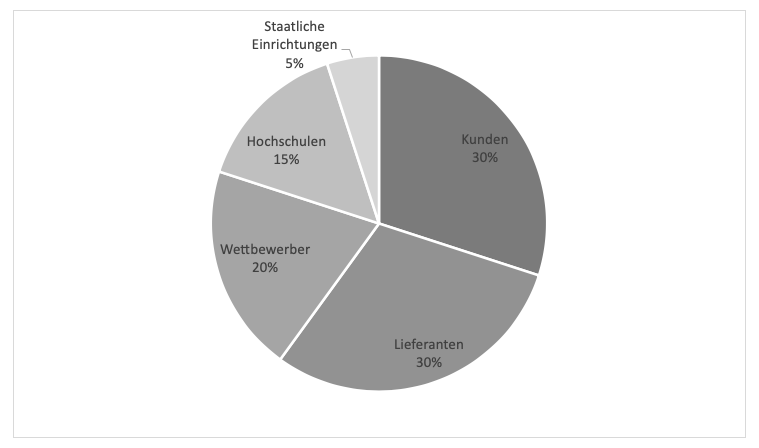I understand an innovation as a planned innovation that has economic success on the market. Digitization in particular offers numerous new possibilities. I would like to present two studies that I have highlighted in the course of my research. The first study examines possibilities for generating innovation in companies, the second study focuses on the financing of innovations in companies.
Study 1: Lünendonk 2019
The first study was carried out by the consulting company Lünendonk (2019). It is an online survey of 70 senior executives from companies. According to the respondents, almost half of the companies have their own unit or staff unit for analyzing new technologies to generate innovations in the company. The other companies state that they develop innovations across all areas of the company. According to the study, the most important results of the innovation departments of the surveyed companies are:
- Generation of marketable products (43%),
- Process improvements (14%) and
- Prototypes (11%).
Another factor with regard to generating innovations is the internal suggestion system. More than two-thirds of those surveyed state that ideas are rewarded with a bonus and that these mainly come from the management level. Another option is to work with external partners, something that more than half of the participants are currently doing. These are mostly research institutes, customers and suppliers. According to the participants, special potentials that arise from such cooperation are:
- Know-how transfer (83%),
- Early detection of trends (62%) and
- Get to know technologies (58%).
Study 2: ZEW 2016
Another study was carried out by the Center for European Economic Development – ZEW (2016). Data from surveys and expert interviews as well as from practical workshops by or with over 80 executives from all industries, mostly SMEs, were evaluated.
The majority of the SMEs surveyed (80%) finance new technologies in the context of innovations from current reserves. Only a third use loans or public grants. According to the study, 30% of excess profits are invested in innovations. Overall, the SMEs surveyed in the study often participate in innovations with customers, suppliers and competitors. the following figure shows the distribution of the external innovation projects among the selected partners.

Essential technologies for the purpose of generating innovations are for the SMEs surveyed:
- Desktop software (82%),
- Cloud software (79%),
- Embedded machine systems (33%) and
- Big data applications (14%).
Conclusion
In general, both studies show that innovations are generated either internally by departments / staff units or with external partners. In this way, human resources and costs can be shared. Many innovations relate to the area of process improvements and are implemented with the help of desktop or cloud software.
swell
Lünendonk. (2019). Innovative business models, products & services. Retrieved May 20, 2020, from https://www.luenendonk.de/produkte/studien-publikationen/luenendonk-studie-2019-innovative-geschaeftsmodelle-produkte-services/
ZEW. (2016). Final report: Innovative SMEs 2025 – challenges, trends and recommendations for action for business and politics Study on behalf of the Federal Ministry for Economic Affairs and Energy Retrieved May 20, 2020, from http://www.bmwi.de/Redaktion/DE/Publikationen/Studien/studie-endbericht-innovativen-mittelstand-2025.pdf?__blob=publicationFile&v=14
[werbung] [fotolia]


